How to Make Test Batches of Soap
Learn how to make small test batches of soap to try out new colorants, additives, and essential oil blends.
I will cover how to make test batches of soap for both cold process soap (CP) and melt and pour base (MP) in this article! ?
I frequently get questions about adding various things to soap that I just haven’t tried yet, such as freeze dried raspberries, or ground fenugreek seeds.
My usual reply is that I haven’t tried that particular item myself, but the soapmaker could make a mini test batch and see what happens!
Small test batches of soap are the perfect way to try out a new colorant, essential oil blend, or recipe experiment, without wasting a bunch of ingredients, in case an idea doesn’t work out quite as planned.
The best part is that once you perform the experiment, you own that information firsthand. Whether it succeeds or fails, the knowledge will stick with you and help you grow as a soapmaker.
I’m a huge fan of making test batches! I’m always trying new ideas and experiments, and these little batches make it possible to do so, without breaking the bank. ?
How to Size Your Test Batches – Cold Process Soap
Since colorant and essential oil rates are based on PPO — per pound of oil (16 ounces/454 grams) in a recipe — it works out best to make test batches with 8 ounces (1/2 pound) or 4 ounces (1/4 pound) of oil.
For example:
If you want to know how 1 tsp PPO of new-to-you colorant looks in soap, you could make a batch of soap with 8 ounces of oil in it, and use 1/2 tsp of the colorant.
Or, you could use 1/4 tsp of the new colorant in a recipe with 4 ounces of oil total in it, for a similar look/rate.
Another way to look at it:
1 tsp colorant could be used in a recipe with 16 ounces of oil
1/2 tsp colorant could be used in a recipe with 8 ounces of oil
1/4 tsp colorant could be used in a recipe with 4 ounces of oil
You can structure your test recipe however you like, but here’s one I often use:
CP Soap Test Recipe – 8 oz (227 g) Oils
(This recipe has 1/2 pound of oils in it.)
- 2.26 oz (64 g) distilled water (2:1 water:lye)
- 1.13 oz (32 g) lye (5% superfat)
- 4 oz (113 g) olive or rice bran oil (50%)
- 2.5 oz (71 g) coconut oil (31%)
- 0.5 oz (14 g) castor oil (6%)
- 1 oz (28 g) refined shea, cocoa, or kokum butter (13%)
You can also divide the recipe exactly in half, to make a 4 ounce (1/4 pound) oils test recipe.
Tips for Making Test Batches of Cold Process Soap
Use a small but tall and skinny container for mixing – a large yogurt container works well.
One quart plastic paint containers work well too.
You want to make sure your immersion blender is fully submerged, so a shallower container is not recommended.
Observe the test bars as they cure – do they hold color and scent well, is there anything you’d change?
If so, write it down to remember for next time.
My Soapmaking Journal is perfect for recording Cold Process Soap recipes & experiments!
How to Make Test Batches of Melt & Pour Soap
Not a cold process soapmaker? No worries! You can use the same idea, only with ready made soap base, instead of using lye, water, and oils.
What I do in that case is split the melt and pour base into an amount that’s easily divisible by 16. (Since there’s 16 ounces of base in a pound, and the additives are often figured at per pound of base.)
So if you find a guide that says to use 1 teaspoon rose clay per pound (16 oz) of base, you could divide those numbers by 4 and use:
1/4 teaspoon rose clay + 4 ounces of base
Or if you see a blend that calls for 3 grams of bergamot and 1 gram of rosemary for 16 ounces of base, that would be:
4 ounces of base (16 ounces divided by 4)
0.75 g bergamot (3 grams divided by 4)
0.25 g rosemary (1 gram divided by 4)
If your scale won’t measure that tiny of an amount, then you could use estimated teaspoon equivalents:
0.5 g essential oil is about 1/8 of a teaspoon
1 g is about 1/4 teaspoon
2 g is about 1/2 teaspoon and so forth
So the 0.25 g rosemary would = about 1/16 of a teaspoon,
and the 0.75 g of bergamot would = about 1/8 tsp + 1/16 tsp.
Coming soon – I’ll share an article on using essential oils in melt and pour soap. For cold process soapmaking, check out: 30 Essential Oils for Soapmaking + Printable Chart (cold process)
For more soapmaking recipes & tips, check out my print books:

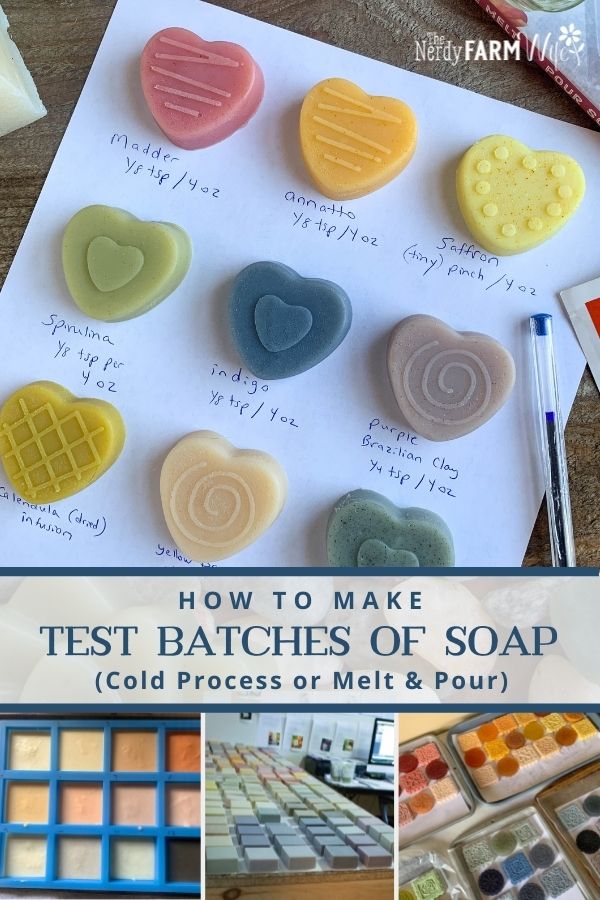
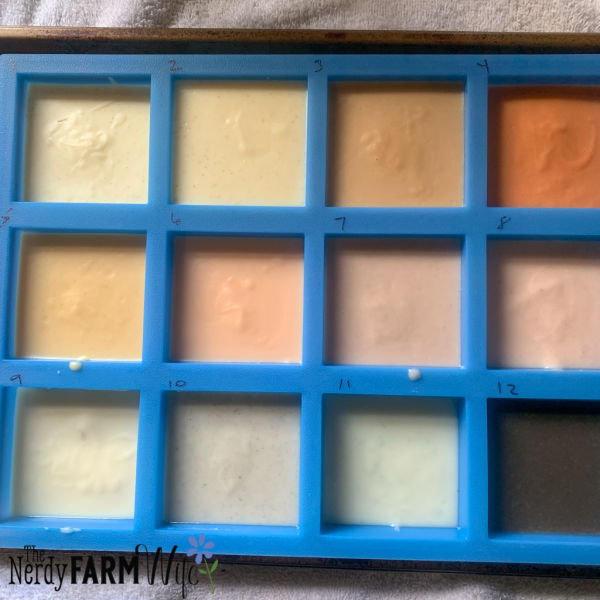
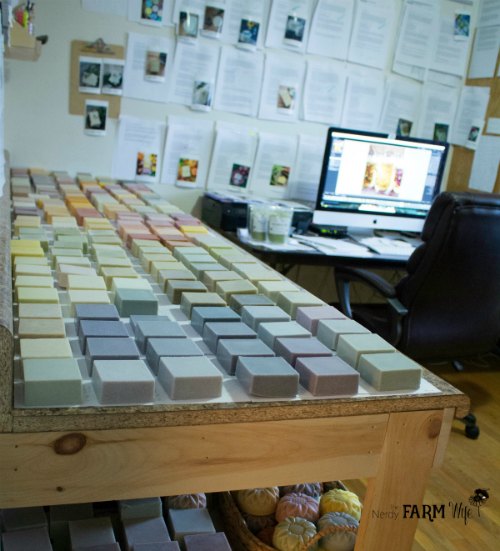
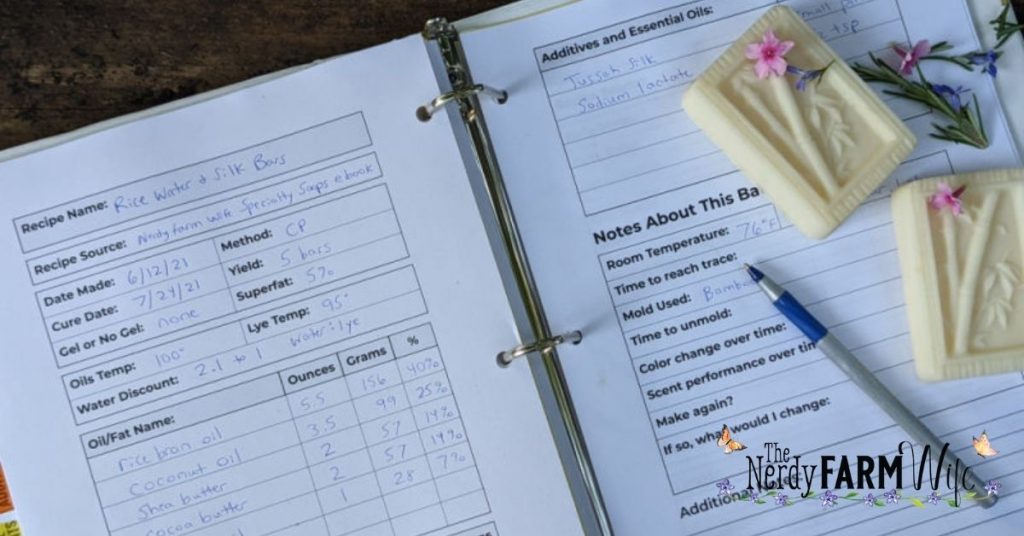

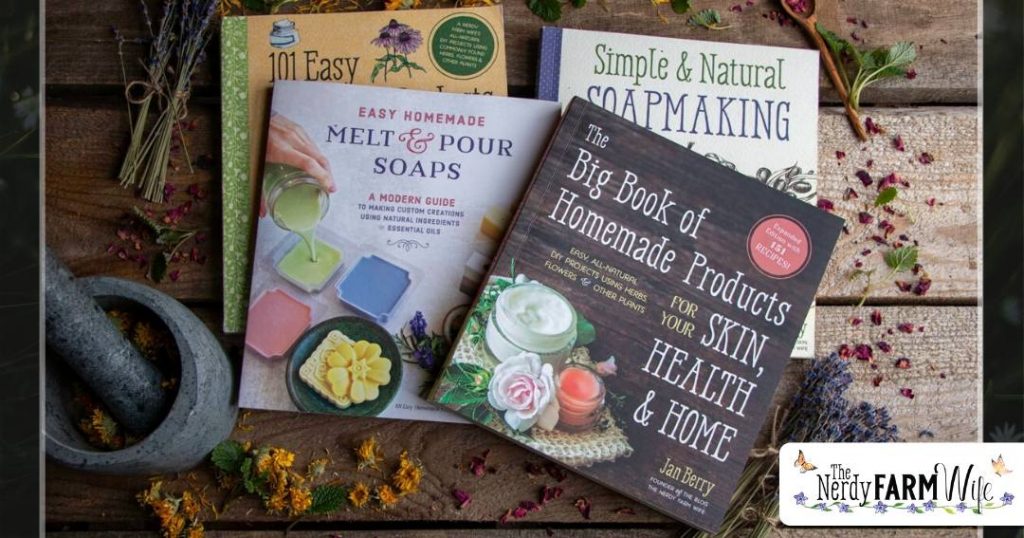

Pardon my ignorance but…when making a test batch you make a batch of soap and divide that batch into how ever many test soaps you’d like to try correct? At what point during trace do you divide the soap batter? Doesn’t it continue from light trace to full trace quickly?
Hi Roberta! That’s also a way to make test batches – make up one big batch of soap and divide the batch into the amount of test soaps you want to use.
In that case, you would divide the soap when it *just* reaches emulsion, or at the very lightest trace you can. Often hand stirring is a good way to mix in the item you want to test.
I’ve done test batches like that in the past, but what I like to do now is the way I wrote about here – make up a bunch of small individual separate batches at one time. (Kind of assembly line style.)
So I’ll have a container of oil and container of lye solution for one colorant or such I want to try, then another container of oil and another container of lye solution for the second colorant or test ingredient, and so forth.
I’ll make 6 to 12 small test batches in the same soaping session, rather than one giant batch, divided out in 12 portions.
I like this way best for colorants so that I can add the test ingredient with the hot lye solution, or with the oils, that way it makes sure everything is mixed in well before trace.
However, making up one big batch and dividing it equally does work well for essential oil test blends.
So if you had 4 test blends to try out, you could divide up a batch of soap that has 16 ounces of oil in it (use a scale to divvy up the soap batter in equal quarters).
Then divide the essential oil blend in 1/4ths and add one each, to each quarter of the test batch.
It comes down to each soapmaker’s personal preference, but both ways can work! ?
I would like to test different oils and butters. What is the best way to test this.
Hi Diedre! If you want to swap oils and butters in this test recipe (or another favorite recipe), then you could use the same method of testing as shown, just trade out an oil and/or butter each batch.
In most cases, there won’t be a big, if any, lye change, but you’ll want to run the altered recipe through a lye calculator just to make sure the lye amount is still good.
I really like the one at Soapee: https://soapee.com/calculator – but the calculator at Majestic Mountain Sage https://www.the-sage.com/lyecalc/ is one of the most beginner friendly & works well too!
You might also find my chart of various soapmaking oils & their properties helpful for your experiments! ?
https://thenerdyfarmwife.com/soapmaking-oils-chart/
I want to use goat milk in my soap but I want to test it first to ensure I am using the right amounts; do I still use the 64g for a test batch but replace the water with milk? and do I need more sodium hydroxide when using the milk? Thanks for all your amazing recipes and tips!
Hi Lauren! Yes, you can use the same amount of milk instead of water in the test recipe.
Most soapmakers worry about adjusting the sodium hydroxide amount, though full fat (whole) milk does add a little bit of extra superfat – so if you normally like a 6% superfat, you may like a 5% superfat for milk soaps instead.
Hi Jan,
I’m using your recipe for the basic palm free soap with butters (page 38 of your soapmaking book) Now, to use this recipe to make test batches i’m dividing it by 5 as the recipe is for 2.5lbs of soap, and then plan to half it to get 8oz of soap for testing. However when i do this i’m quite aware that my levels of waters and Lye are a lot lower than yours above, so just to get a LBs worth of water would be 49 grams, whereas yours for 1/2 a pound is 2.26 oz (64 g) distilled water? Would me making the recipe work? im so confused!
Thanks, Fe
Hi Jan,
Please excuse my last email, i an from the UK and use grams/Kilos and have just had covid (brain fog) and apparently am terrible at maths! Not sure where i got the divide by 5 thing from!
Thanks,
Fe
Hi Fiona, No problem! I’m just getting over it too and the brain fog is a very real thing! ❤
Did you get your test recipe figured out, or do you still need help getting it to 8 oz of oil?
Just let me know and I’ll be glad to help!
Hi Jan! I recently purchased about 6 of your books (love them all!) But I’m wanting to know instead of making smaller batches, I would like to make bigger batches. I use the recipes from your book and website. Would I just multiple the original recipe if I wanted a double the amount or even triple the amount of soap?
Hi Heather! Yes, you can exactly double my recipes with no problem.
They should work to triple them too, but as you get larger and larger batches, you may want to tweak certain ingredient ratios.
Anytime you increase or decrease a recipe size, just run the new amounts through a lye calculator. I like Soapee or Soapmaker’s Friend.
https://soapee.com/calculator
https://www.soapmakingfriend.com/soap-making-recipe-builder-lye-calculator
Happy soapmaking! :)